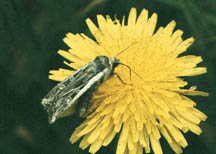It’s the time of year when miller moths invade the Front Range on their annual migration from the eastern plains into the mountains. And this year’s migration is a particularly crowded one! But why are all of these miller moths migrating? Where are they ultimately headed? Is there any way to keep them out of our houses??
The Colorado State University Extension provides all the information you need in their Miller Moths fact sheet and Questions and Answers about Miller Moths.
What is a miller moth?
The “miller moth” is actually not a specific species, but is a name given to any type of moth that becomes abundant around human homes. What we refer to as a “miller moth” is the adult stage of the army cutworm.

Army cutworms begin life in weedy areas of wheat fields, alfalfa fields, or turfgrass. They hatch into baby caterpillars in late summer or early fall and spend the winter feeding on vegetation. The army cutworm earns its name because of their habit of forming groups of fellow army cutworms to charge across fields or highways in search of new food sources.
Army cutworms grow to their full size in the spring and burrow into the soil to pupate. After three to six weeks, they emerge as adult miller moths.
Where are they migrating?
The miller moths that we see in Eastern Colorado and along the Front Range are migrating westward towards higher elevations in the foothills and mountains. A miller moth’s flight from the plains usually lasts five to six weeks between mid-May and early June.
Experts think that miller moths head towards the mountains to find a reliable source of summer flowers, which provide nectar that moths use for food. Miller moths are crucial pollinators for flowers all along their migration route, and also provide a high-protein food source for bats, birds, and even bears.
Miller moths embark on an autumn migration back towards the Eastern plains in order to lay eggs, and the annual cycle begins again.
Tips for living in harmony with miller moths
Surges of miller moths during their westward migration can certainly be a nuisance! The good news is that miller moths rarely damage our homes and only migrate in high concentrations for two to three weeks in the spring. Miller moths will not lay eggs indoors or eat holes into your favorite wool sweaters.
To keep the moths outside and on their migratory way, seal any openings around your doors and windows. Miller moths travel at night and are attracted to light, so turning off unnecessary lights in and around your home can reduce the number of moths ending up inside. Landscaping can also attract moths, because they like to hide out in dark, dense plants like spruces and pines.
When you’ve had just about enough the miller moths in your space, try to remember that miller moths are a temporary nuisance that are an essential part of our Colorado ecosystem! They’ve been following this migration route for a lot longer than we’ve built structures blocking their way. And, they’re pretty easy to catch and let back outside.
- Colorado’s Governors: Ralph L. Carr - July 11, 2025
- Celebrating Colorado’s immigrant heritage - June 27, 2025
- Colorado’s Scenic and Historic Byways: Guanella Pass - June 6, 2025